致用英语综合教程unit1-2教案
- 格式:doc
- 大小:187.00 KB
- 文档页数:24
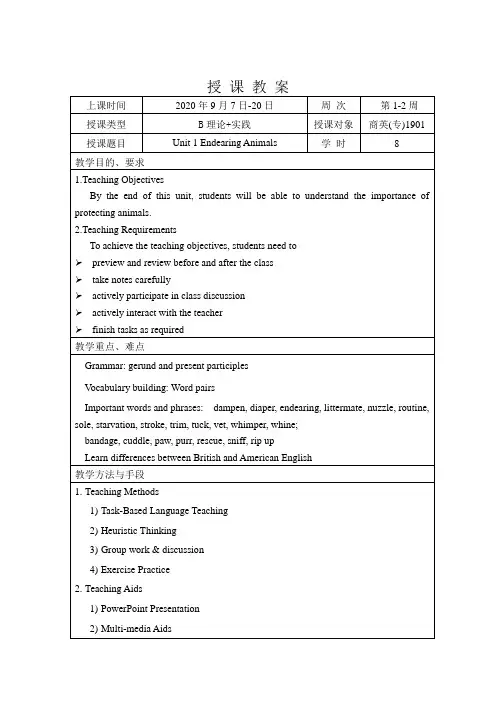
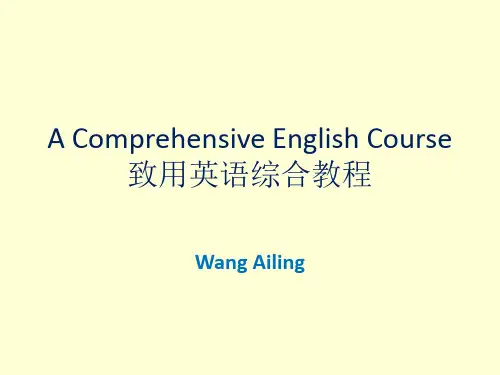
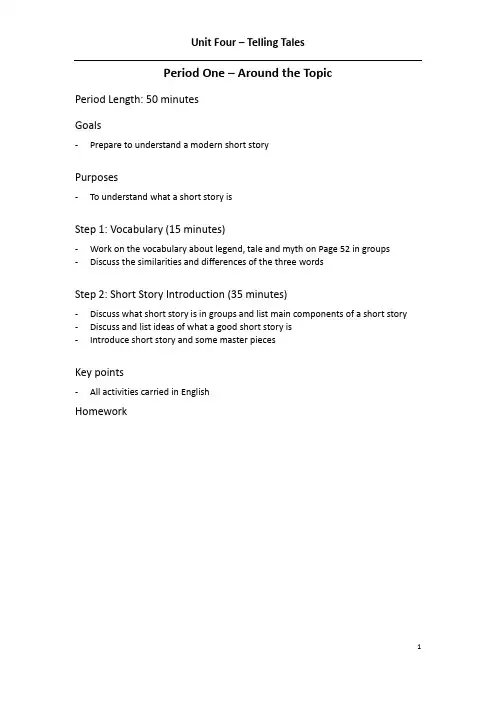
Period One – Around the TopicPeriod Length: 50 minutesGoals-Prepare to understand a modern short storyPurposes-To understand what a short story isStep 1: Vocabulary (15 minutes)-Work on the vocabulary about legend, tale and myth on Page 52 in groups-Discuss the similarities and differences of the three wordsStep 2: Short Story Introduction (35 minutes)-Discuss what short story is in groups and list main components of a short story -Discuss and list ideas of what a good short story is-Introduce short story and some master piecesKey points-All activities carried in EnglishHomeworkPeriod Two – Reading (1): Mr. JonesPeriod Length: 50 minutesGoals-Vocabulary and grammar-Discourse knowledgePurposes-Learn new words and expressions-Understand key grammar points-Understand related discourse knowledgeStep 1: Pre-reading Tasks (15 minutes)-Discuss briefly the words and the task on Page 54 in groups-Check briefly the preview results from studentsStep 2: Reading activity (Part One: 25 minutes)-Listen to the reading-Ask students to present new words and sentences in groups-Ask students to give feedbacks for the information presented-Give more explanations to the new words and sentences-Provide extra knowledge about new words-Guide more on sentences and grammarStep 3: Summarization (10 minutes)-Summarize the words and sentences-Summarize the text learntKey points-Instructions and tasks carried in English, Chinese is used only when necessaryHomework-Review the learnt sections-Preview the following parts and exercisesPeriod Length: 50 minutesGoals-Vocabulary and grammar-Discourse knowledgePurposes-Learn new words and expressions-Understand key grammar points-Understand related discourse knowledgeStep 1: Pre-reading Tasks (15 minutes)-Discuss briefly the previously learnt part for understanding-Check briefly the preview results from studentsStep 2: Reading activity (Part Two: 25 minutes)-Listen to the reading-Ask students to present new words and sentences in groups-Ask students to give feedbacks for the information presented-Give more explanations to the new words and sentences-Provide extra knowledge about new words-Guide more on sentences and grammar-Check the comprehension questions on Page 56Step 3: Summarization (10 minutes)-Summarize the words and sentences-Summarize the text learntKey points-Instructions and tasks carried in English, Chinese is used only when necessaryHomework-Review the learnt sections-Preview the following parts and exercisesPeriod Length: 50 minutesGoals-Enhance the vocabulary abilityPurposes-Learn detailed usage of certain words-Learn detailed usage of certain language structuresStep 1: Exercise A (15 minutes)-Work Vocabulary and Structure exercise A on Page 56 in groups -Check and compare answers in groups and negotiate them-Ask students to present their answers-Provide feedbacks for answersStep 2: Exercise B (15 minutes)-Work exercise B on Page 57 in groups-Check and compare answers in groups and negotiate them-Ask students to present their answers-Provide feedbacks for answersStep 3: Exercise C (20 minutes)-Work exercise C & D on Page 57 in groups-Check and compare answers in groups and negotiate them-Ask students to present their answers-Provide feedbacks for answersKey points-Instructions and activities be carried in EnglishHomework-Finish Writing Task on Page 58 and turn them in due next period -Prepare for the grammar and vocabulary exercisesPeriod Five – Language in UsePeriod Length: 50 minutesGoals-Grammar knowledge and vocabulary buildingPurposes-Narrative Tenses-Phrasal Verbs with off and outStep 1: Narrative Tenses (30 minutes)-Test grammar knowledge on Page 59 for checking grammar abilities-Work on exercises A, B & C on Pages 59 & 60 in groups-Ask students to present their answers and provide necessary explanations -Give supplementary information on those structures if necessaryStep 2: Phrasal Verbs with off and out (20 minutes)-Work on exercises A & B on Pages 28 in groups-Ask students to present their answers and explain Compound words-Give supplementary information on Compound words if necessaryKey points-Give instructions in English-Explain grammar knowledge in ChineseHomeworkPeriod Six – Extension: The Enchanted KnifePeriod Length: 50 minutesGoals-Extend reading abilitiesPurposes-Apply previously learnt vocabulary and cultural knowledge in reading-Develop reading abilities-Improve abilities on negotiation and discussionStep 1: Reading (20 minutes)-Ask students to read The Enchanted Knife on Page 30 in groups-Understand new words and sentences within the group by negotiating in English -Finish Vocabulary Check on Page 64Step 2: Discussion (30 minutes)-Discuss questions listed on Page 64-Ask each group to present their opinions for the questions in front-Give feedbacks and remarks for presentationsKey points-Inspect group discussions and give guidance to promote discussionsHomework-Review previously learnt materials-Prepare for the ProjectPeriod Length: 50 minutesGoals-Teamwork abilitiesPurposes-Apply previously learnt words and cultural knowledge into actual use-Develop teamwork abilitiesStep 1: A Make-up story (25 minutes)-Make up a strange story following the example of Mr. Jones with clue words and instructions on Page 62Step 2: An odd experience (25 minutes)-Work in groups to finish the story of An odd experience on Page 62-Ask each group to present their stories and provide remarksKey points-All preparations and negotiations be carried in English-Give guidance while students prepare the projectHomeworkPeriod Length: 50 minutesGoals-See abovePurposes-See aboveStep 1: Prepare for a surprise (25 minutes)-Share your stories with others and present them with pictures if possibleStep 2: Evaluate stories (25 minutes)-Give remarks to the presentations after the whole class have finished presenting stories-Group members should also talk about what they have learnt from this presentation project.Key points-Give instructions for presentationHomework-Revise writings according to the feedbacks and remarks received-Turn the revised copies before next periodPeriod Nine – Culture Tips: AthenaPeriod Length: 50 minutesGoals-Understand part of western culture from another perspectivePurposes-Help students to understand western culture-Help students to learn more cultural expressionsStep 1: Warm-up (15 minutes)-Read materials on Athena on Page 65-Help on any new words if necessaryStep 2: Open Discussion (35 minutes)-Ask students to talk more about western myths and tales if possible-Encourage students to pay more attention to the western culture while learning a languageKey points-All activities be carried in EnglishHomeworkPeriod Ten – Learning to Learn Period Length: 50 minutesGoalsPurposesStep 1Step 2Key pointsHomework。
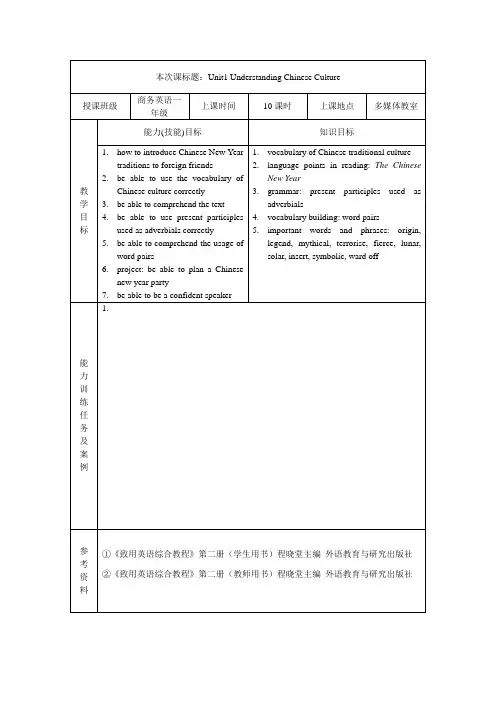
Section One Around the topicStep 1 Topic introduction:Many Chinese students find it very difficult to introduce Chinese culture to foreign friends.The biggest problem is that they don’t know how to express their understanding about Chinese culture or how to explain some typical concepts in Chinese culture. Chinese learners of English as a foreign language should not only study western cultures, but also deepen their understanding of Chinese culture, so that they can introduce it to the outside word.Step 2 Your ideasWork in groups or pairs and discuss the following questions1)Why is spring Festival so important for the Chinese people?2)What do you usually do during the Spring Festival3)Are there any special celebration activities in your hometown during Spring Festival?4)In what ways do you think the Spring Festival has Changed?How much do you know about the Chinese New Year?A.Which day in the 15-day celebration is for the sons-in-laws to pay a visit to theirparents-in-law?The third and fourth days.B. What is the fifth day called?Po Woo.C. How many kinds of traditional New Year food do you know?Dumplings, a whole fish, chicken, New Year cake…D. Do we use knives or scissors on New Year's Day?NO. They may cut off fortune.E. What fruit do we usually use as a decoration during the Spring Festival?Oranges and Tangerines. They are symbols for abundant happiness.Step 3 VocabularyThere are some special things about Spring Festival, which are difficult to translate into English. Here are some English words and expressions related to the Spring Festival. Try to get their meanings.Remind students that names of some typical Chinese things do not have exact equivalents in English. Ask them to guess the meaning of the English words and phrases related to theThe teacher can offer students a particular situation for students to practice in which students can give a brief talk with some of the words in the table above so that they can master a better usage of these words.Step 4 Listening and speakingAsk students to read the questions first. Then play the recording and encourage them to take notes while listening.1.Q: What are they talking about?A: They are talking about the Spring Festival.2.Q: How did Li Ming spend his holiday?A: Li Ming spent his holiday with his family in his hometown.3.Q: What is Susan curious about?A: Susan is curious about how Chinese people celebrating their Spring Festival.4.Q: What make the Spring Festival different from other holidays?A: Giving presents and staying with the family.5.Q: What do Chinese People do on the Eve of the Spring Festival according to the recording?A: In the past, all the members of a family would stay at home making dumplings together.Now many people enjoy watching TV. During the day, children wear their new clothes. The evening is usually spent playing games, talking, eating and drinking.Step 5 A quizDuring the Spring Festival, some things are believed to bring good luck for the new year, while other things might bring bad luck. Read the items in the table below and decide whether they bring good luck or bad luck. When you finish, compare your answers in pairs.This quiz is just for fun. Remind students that we should not be superstitious and the dos and don’ts during the Spring Festival are only parts of our traditions and customs. We should hold a right attitude towards them.Ask students to do the exercise first based on their own understanding and then compare their answers with their partners’. They may discuss them if necessary. When they finish, you may show and explain answers.Section Two ReadingThis section introduces the tradition of the Chinese New Year. By studying it, students will learn more about the legend of Nian and traditional Chinese New Year celebration activities. Most importantly, students will learn how to introduce the Chinese New Year to foreign friends.Step 1 Pre-reading tasksBefore you read, discuss the following questions in groups:1.Do you know why we call the Spring Festival “Nian”?2.Do you know why we Chinese celebrate the New Year at a different time from the Westernworld?Read the instruction as a class. Divide students into groups. Ask them to discuss the questions. Activate their prior knowledge of the Spring Festival and encourage them to share informationwith others. Pick some volunteers to answer these tow questions as representatives of their group. Step 2 Text illumination1)Ask several students to read the whole text in order to check whether they preview thetext and get a general understanding bout it or not beforehand.2)Ask students to summarize the text3)The teacher can put the comprehension check either before or after illuminating the textaccording to the needs of class and the students’ comprehension ability.4)Illuminate the text, during the process of which the teacher can encourage students tohighlight or underline the important parts when they read the text in detail. Try to explain that it can help students to grasp the important details and review important points Language points:1. legend n.story handed down from the past, especially one that may not be true 传奇,传说e.g. The legend of Robin Hood is well-known.2. mythical adj. existing only in an ancient story, imagined or invented 神话的,虚构的e.g. Qi Lin is a mythical Chinese creature which is similar to a unicorn.myth n. 神话e.g. ancient Greek myths3. terrorise v. to fill or overpower with terror, to terrify 使惊恐不安,恐吓e.g. The local gangs terrorised the neighborhood.4. fierce adj. violent and angry 凶猛的,凶狠的e.g. Swans are always fierce in defense of their young.The leopard looks fierce.5. lunar adj. determined or measured in reference to the moon 根据月亮决定或测定的e.g. The Chinese New Year falls on lunar January, 1st.6. solar adj. determined or measured in reference to the sun 根据太阳决定或测定的e.g. Solar energy is one kind of important energy nowadays.7. insert v. to put or set into, between, or among 插入,嵌入e.g. The editor inserted an advertisement in the newspaper.insert a key into a lock8. symbolic adj. representing a particular idea or quality 象征的,符号的e.g. The cross is symbolic of Christianity9. ward off to keep away (somebody/something that is dangerous or unpleasant) 挡开,避开e.g. He carried a gun to ward off possible attacks.Step 3 Post-reading exercises1.What is the significance of the following things during the Spring Festival?2.Discussion:Read the instruction as a class. Divide students into groups of four. Ask them to discuss these questions. Get feedback when they finish. Try to encourage them to express their opinions thoroughly in English.3.V ocabulary and structureThis part is about some vocabulary and structure exercises related to the text. Ask students to finish them independently beforehand. Check their answers in class. Try to encourage them to explain by themselves to check whether they fully understand the exercises or not. The teacher is supposed to give some explanations if necessary.A.Work out the meanings of the underlined words with the help of the context.B.Fill in the blanks with the words below. Change the form where necessary.plete each pair of the sentences with the correct form of the same verb, one as apresent participle (-ing) and the other as a past participle (-ed).4.WritingRead the instruction as a class. Leave the writing task as homework. Check their work next time.Write down your experience about the Spring Festival. The following questions may help you to come up with some ideas.1)How does your family prepare for the Spring Festival?2)What traditional activities does your family do to celebrate the Spring Festival?3)What special activity do you like most when you are celebrating the Spring Festival?Section Three language in use: present participles used as adverbialsStep 1 test your grammarThe aim of this practice is to make students aware of the present participles used as adverbials. Based on their study of the text, they may gain a deeper understanding by doing these exercises. Try to encourage students to explain by themselves through recalling and understanding of this grammatical phenomenon.Step 2 illumination and developmentBriefly explain the grammatical knowledge of participles. Then ask students to finish these exercises. Check their work when they finish.一、现在分词做状语(表原因,时间,条件,让步,行为方式,伴随状况)现在分词与主句的主语一致,且形成主谓关系,就是说现在分词的动作发出者是主句的主语。
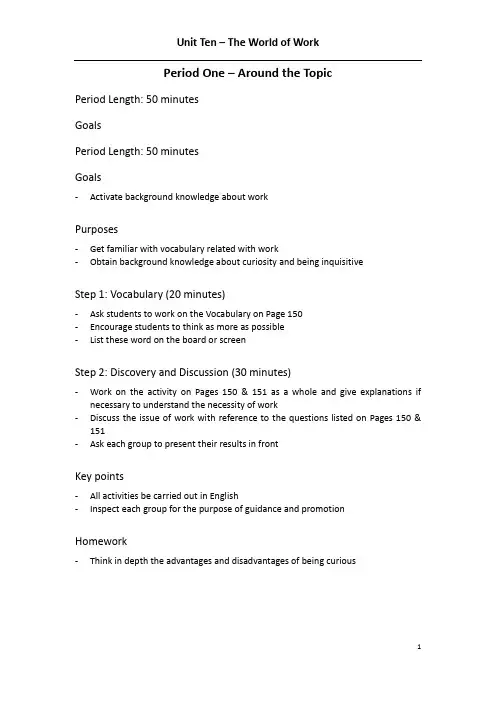
Period One – Around the TopicPeriod Length: 50 minutesGoalsPeriod Length: 50 minutesGoals-Activate background knowledge about workPurposes-Get familiar with vocabulary related with work-Obtain background knowledge about curiosity and being inquisitiveStep 1: Vocabulary (20 minutes)-Ask students to work on the Vocabulary on Page 150-Encourage students to think as more as possible-List these word on the board or screenStep 2: Discovery and Discussion (30 minutes)-Work on the activity on Pages 150 & 151 as a whole and give explanations if necessary to understand the necessity of work-Discuss the issue of work with reference to the questions listed on Pages 150 & 151-Ask each group to present their results in frontKey points-All activities be carried out in English-Inspect each group for the purpose of guidance and promotionHomework-Think in depth the advantages and disadvantages of being curiousPeriod Length: 50 minutesGoals-Vocabulary and grammar-Discourse knowledgePurposes-Learn new words and expressions-Understand key grammar points-Understand related discourse knowledgeStep 1: Pre-reading Tasks (15 minutes)-Discuss briefly the short passage on Page 152 in groups-Check briefly the preview results from studentsStep 2: Reading activity (Part One: 25 minutes)-Listen to the reading-Ask students to present new words and sentences in groups-Ask students to give feedbacks for the information presented-Give more explanations to the new words and sentences-Provide extra knowledge about new words-Guide more on sentences and grammarStep 3: Summarization (10 minutes)-Summarize the words and sentences-Summarize the text learntKey points-Instructions and tasks carried in English, Chinese is used only when necessaryHomework-Review the learnt sections-Preview the following parts and exercisesPeriod Length: 50 minutesGoals-Vocabulary and grammar-Discourse knowledgePurposes-Learn new words and expressions-Understand key grammar points-Understand related discourse knowledgeStep 1: Pre-reading Tasks (15 minutes)-Discuss briefly the previously learnt part for understanding-Check briefly the preview results from studentsStep 2: Reading activity (Part Two: 25 minutes)-Listen to the reading-Ask students to present new words and sentences in groups-Ask students to give feedbacks for the information presented-Give more explanations to the new words and sentences-Provide extra knowledge about new words-Guide more on sentences and grammar-Check the comprehension questions on Page 154Step 3: Summarization (10 minutes)-Summarize the words and sentences-Summarize the text learntKey points-Instructions and tasks carried in English, Chinese is used only when necessaryHomework-Review the learnt sections-Preview the following parts and exercisesPeriod Length: 50 minutesGoals-Enhance the vocabulary abilityPurposes-Learn detailed usage of certain words-Learn detailed usage of certain language structuresStep 1: Exercise A (15 minutes)-Work Vocabulary and Structure exercise A on Page 155 in groups -Check and compare answers in groups and negotiate them-Ask students to present their answers-Provide feedbacks for answersStep 2: Exercise B (15 minutes)-Work exercise B on Page 155 in groups-Check and compare answers in groups and negotiate them-Ask students to present their answers-Provide feedbacks for answersKey points-Instructions and activities be carried in EnglishHomework-Finish Writing Task on Page 156 and turn them in due next period -Prepare for the grammar and vocabulary exercisesPeriod Five – Language in UsePeriod Length: 50 minutesGoals-Grammar knowledge and vocabulary buildingPurposes-Present Simple and Present Continuous-Phrasal VerbsStep 1: Present Simple and Present Continuous (30 minutes)-Test grammar knowledge on Page 157 for checking grammar abilities-Work on exercises A, B & C on Pages 157 & 158 in groups-Ask students to present their answers and provide necessary explanations -Give supplementary information on those structures if necessaryStep 2: Phrasal Verbs: Liberal or Idiomatic? (20 minutes)-Work on exercises A & B on Pages 159 in groups-Ask students to present their answers and explain phrasal verbs-Give supplementary information on phrasal verbs if necessaryKey points-Give instructions in English-Explain grammar knowledge in ChineseHomeworkPeriod Six – Extension: Do jobs change people? Period Length: 50 minutesGoals-Extend reading abilitiesPurposes-Apply previously learnt vocabulary and cultural knowledge in reading-Develop reading abilities-Improve abilities on negotiation and discussionStep 1: Reading (20 minutes)-Ask students to read Do Jobs Change People? on Page 162 in groups-Understand new words and sentences within the group by negotiating in English -Finish Vocabulary Check on Page 163Step 2: Discussion (30 minutes)-Discuss the job related topics in class-Ask each group to present their opinions for the questions in front-Give feedbacks and remarks for presentationsKey points-Inspect group discussions and give guidance to promote discussionsHomework-Review previously learnt materials-Prepare for the ProjectPeriod Length: 50 minutesGoals-Teamwork abilitiesPurposes-Apply previously learnt words and cultural knowledge into actual use-Develop teamwork abilitiesStep 1: Search for a Job Vacancy (25 minutes)-Work in groups and decide which role you would like: a job hunter or an interviewer? With reference to Page 160.-Read the above help-wanted ad. What qualities are needed for a good manager?Step 2: Vocabulary (25 minutes)-Ask students to work in pairs or groups to work on the vocabulary about jobs-Write down the questions you should ask the job hunter or interviewer.Key points-All preparations and negotiations be carried in English-Give guidance while students prepare the projectHomeworkPeriod Length: 50 minutesGoals-See abovePurposes-See aboveStep 1: Act out a job Interview (25 minutes)-Find a partner, either a job applicant or an interviewer and act out an interview.Be polite and friendly. You should at least interview or being interviewed once. .Step 2: The Best Person for the Job (25 minutes)-Students who have conducted interviews report to the class. First tell the class which questions you asked and then state clearly the reasons why you think you have chosen the right applicant.-Give remarks to the presentations-Group members should also talk about what they have learnt from this project.Key points-Give instructions for discussion and presentationHomework-Revise writings according to the feedbacks and remarks received-Turn the revised copies before next periodPeriod Nine – Culture Tips: What Drives US EmployeeSatisfactionPeriod Length: 50 minutesGoals-Understand part of western culture from another perspectivePurposes-Help students to understand western culture-Help students to learn more cultural expressionsStep 1: Warm-up (15 minutes)-Read materials on What Drives US Employee Satisfaction on Page 164-Help on any new words if necessaryStep 2: Open Discussion (35 minutes)-Ask students to offer more stories related to the topic-Encourage students to pay more attention to the situations that may occur in the job situations in the future.Key points-All activities be carried in EnglishHomeworkPeriod Ten – Learning to Learn Period Length: 50 minutesGoalsPurposesStep 1Step 2Key pointsHomework。
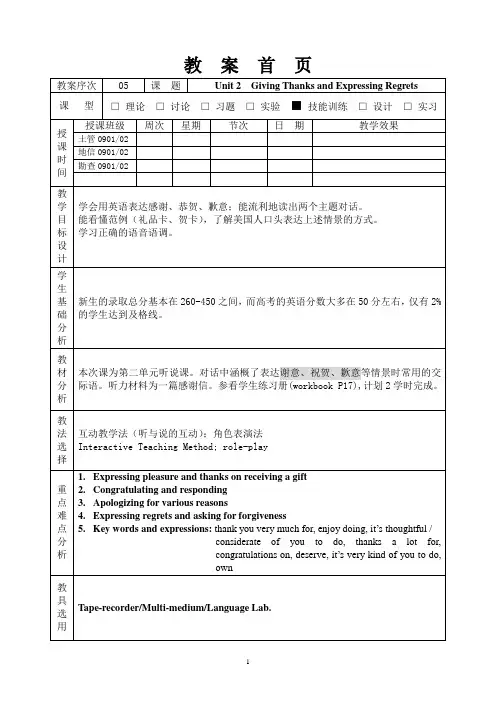
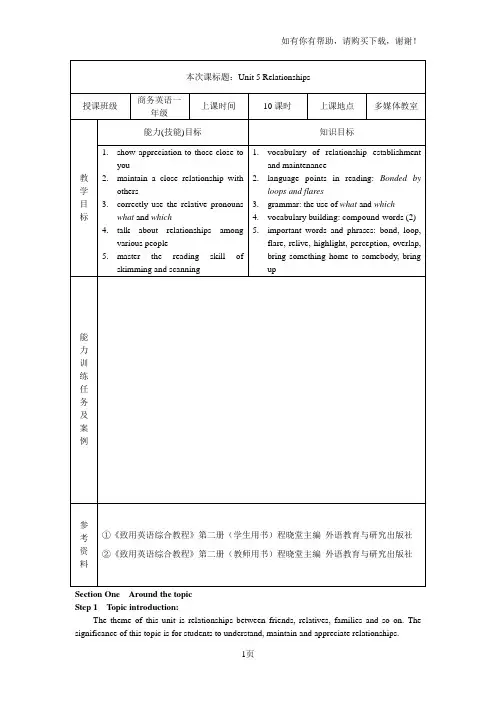
Section One Around the topicStep 1 Topic introduction:The theme of this unit is relationships between friends, relatives, families and so on. The significance of this topic is for students to understand, maintain and appreciate relationships.Step 2 Your ideas1.Listen to the song. Fill the blanks in the lyrics while listening.I believe I can loveYou give me your loving careI believe in what we areI don’t know where I would beWithout you staying with meSometimes, I’m lost in miseryYou will take me all the wayI’m not afraidOh, you and mehand in hand to everywhereAmazing be my friend, oh friendWe are forever friendsOh babyYou give me all the love I needYou are the only onePlay the song twice constantly and then encourage students to tell the answer by themselves. Step 3 vocabularyA.Work in pairs and think of as many English words as possible that havemeanings similar to friendly and unfriendly. Compare your list with anotherpairThis is a pair-work task. Ask students to brainstorm as many related words as possible.Then ask them to exchange opinions with other pairs. You may let them read out thewords they have got in front of the class.B.The underlined adjectives in the sentences below are all about friendliness.Read them and work out the meanings.Ask students to read these sentences carefully and discuss their meanings in pairs. Havethem explain the meanings in English.Answers:Friendly: acting or ready to act as a friendSociable: fond of making friends with people and enjoying being with othersAmiable: having a pleasant and friendly nature; good temperedIntimate: close in relationshipClose: near in relationship, friendshipWarm: friendly in a pleasant wayStep 4 discussionPut the class into small groups. Each group selects one student to note down the opinions of each speaker. After the discussion, you may collect their ideas by having some students give a report. This can be really interesting when show diverse opinions.1). In your opinion, what is a friend? What does friendship mean to you? What do youthink are the most important factors that can keep a long-lasting close relationship with your friends?2). What about with your family members and relatives?3). How can we make our close relationships last long?Step 5 listening and speakingA: Do you have family members, relatives or friends who live in a faraway place? What do you do to keep in touch with them? Do you do the following?●phone them●write letters to them●send them recorded cassettes●send them postcards●have flowers or other gifts delivered to them●e-mail them●send them text messages●visit them during holidays●chat with them onlineB: listening: John lives in Manchester. His sister, Mary, is studying French in Paris. She’s been there for five weeks. He wants to visit her in Paris and he wrote to her about it through an e-mail. He’s just received a message on the answer phone from her.This activity involves skills of both speaking and listening. Use the questions in task A to start a talk among students. The items listed in the text can give students some topics for continuing their talk.After the activity in task A, move on to the listening section. At the same time, ask students to pay attention to decide whether they are true or false. Have a class feedback when they finish. Section 2 Reading: Bonded by loops and flaresThe text Bonded by loops and flares is taken from the newspaper International Herald Tribune, written by David Brooks. Students may find the ideas expressed in this article quite new. Ask students to read the text carefully and have them do exercises individually. When they finish, ask them to exchange and discuss the answers with their partners.Step 1 Pre-reading questionsRead these questions and then put students into small groups for a brief discussion. Give them a few minutes to prepare. Ask one or two groups to tell the whole class their conclusions and reasons when they finish.Do you think people’s perception and thinking are greatly influenced by others? If so, by whom are people most probably influenced? Discuss these questions in groups.Step 2 Text illumination1) Ask several students to read the whole text in order to check whether they preview the textand get a general understanding about it or not beforehand.2) Ask students to summarize the text3) The teacher can put the comprehension check either before or after illuminating the textaccording to the needs of class and the students’ comprehension ability.4) Illuminate the text, during the process of which the teacher can encourage students tohighlight or underline the important parts when they read the text in detail. Try to explain that it can help students to grasp the important details and review important points Language points:1. loop n. a shape like a curve or circle made by a line curving back towards itself 环形,圈状。
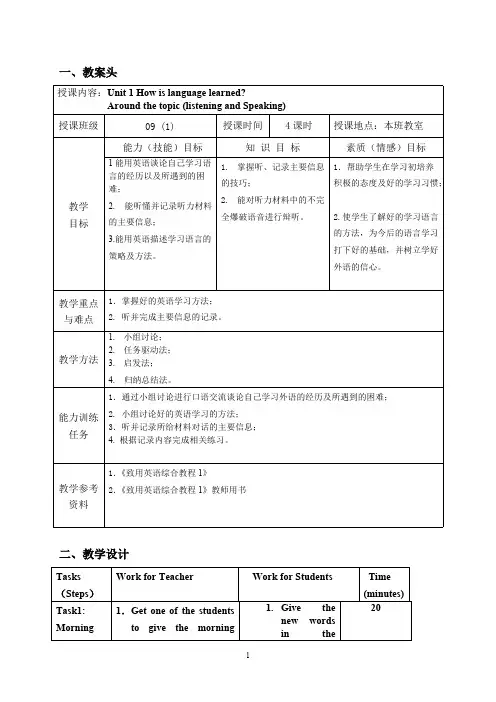
一、教案头授课内容:Unit 1 How is language learned?Around the topic (listening and Speaking)授课班级09 (1)授课时间4课时授课地点:本班教室能力(技能)目标知识目标素质(情感)目标教学目标1能用英语谈论自己学习语言的经历以及所遇到的困难;2.能听懂并记录听力材料的主要信息;3.能用英语描述学习语言的策略及方法。
1. 掌握听、记录主要信息的技巧;2. 能对听力材料中的不完全爆破语音进行辩听。
1.帮助学生在学习初培养积极的态度及好的学习习惯;2.使学生了解好的学习语言的方法,为今后的语言学习打下好的基础,并树立学好外语的信心。
教学重点与难点1.掌握好的英语学习方法;2.听并完成主要信息的记录。
教学方法1.小组讨论;2.任务驱动法;3.启发法;4. 归纳总结法。
能力训练任务1.通过小组讨论进行口语交流谈论自己学习外语的经历及所遇到的困难;2. 小组讨论好的英语学习的方法;3.听并记录所给材料对话的主要信息;4. 根据记录内容完成相关练习。
教学参考资料1.《致用英语综合教程1》2.《致用英语综合教程1》教师用书二、教学设计Tasks (Steps)Work for Teacher Work for Students Time(minutes)Task1: Morning 1.Get one of the studentsto give the morning1.Give thenew wordsin the20report report to the wholeclass;2.Talk about the topic orcomment on their jobs.report;2.Report tothe wholeclass;3.Ask andanswer thequestions.Task 2: Discussion 3.Talk about theexperience of learningEnglish and thedifficulties that evermet while learning;4.Divide the class intosmall groups and getstudents to share theirown experiences oflearning English;5.Invite some to sharewith the whole class.1.Talk about theexperiences oflearning Englishin English;2.Some volunteersshare with theclass.20Task 3: pre-listening activities 1.Get the individual tofinish a quiz.2.Read the scoringmethods andexplanations to theclass.3.Get the Ss to discuss onthe topic: What makesa good Englishlearner ?4.Do class feedback andwrite down the Ss’opinions on the Bb.1.Finish the quiz;2.Count the pointsthey’ve got andfigure out howgood languagelearners they are.3.Discuss in groupsof 4 and preparea presentation infront of class.40Task 4: Discussion 1.Have the students workin groups to discuss theways to learn Englishwell and let them write1.Work in groups todiscuss the waysto learn Englishwell and let them35down;2.Make each groupswrite the ways on theBb;3.Get them to discusswhich ways are the bestand let them talk abouttheir opinions.write down;2.Discuss the bestways to help themto learn English.Task 5: while-listening activities 1. Tell students what theyare going to listen , makethem get ready;2. Ask students to read thequestions first beforelistening;3. Play the recording andencourage them to takenotes while listening;4. Guide them to listen tothe recording three times;5. Get students to checktheir answers..1. Listen for the 1sttime and try to pickout the sameinformation fromthe listeningmaterial as thesuggestions listed onthe Bb.2. Listen for the 2ndtime to note downthe advice. 3. Listenfor the 3rd time tocheck the answers.4. Compare theanswers in pairs.40Task 6 : post-listening activities 1. Play the recording andget the Ss to repeat.2. Get the Ss to discuss ingroups of 4 on Mr.Martin’s opinions.1. Listen and repeat tocorrect the diction.2. Discuss in groups of 4.20Summary Summarize what studentshave learned in this lesson,point out what they shouldmaster.4Homework Pre-learn the words appeared in the word list.1三、教学后记1. 讲课之前让学生用英语简单的介绍一下自己,看看学生的实际水平并相互熟悉,使课堂气氛轻松;2. 在听力练习开始之前,先让学生简单地讨论一下自己的英语学习经历并谈论自己在学习中所遇到的难题以及解决办法,有助于学生更好地抓住听力材料中的关键内容。
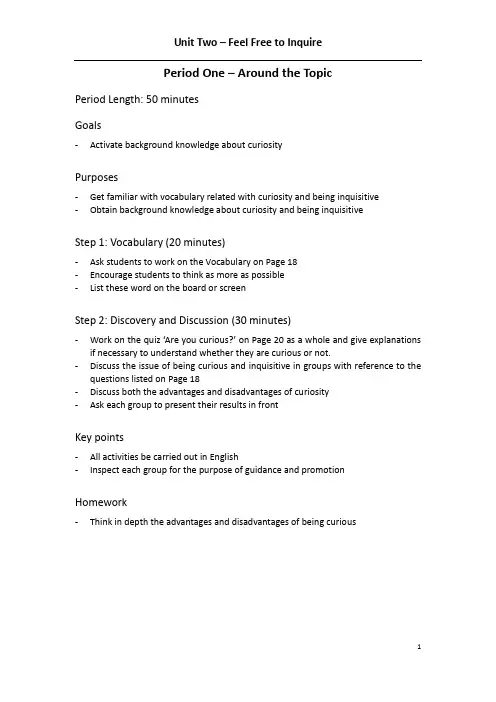
Period One – Around the TopicPeriod Length: 50 minutesGoals-Activate background knowledge about curiosityPurposes-Get familiar with vocabulary related with curiosity and being inquisitive-Obtain background knowledge about curiosity and being inquisitiveStep 1: Vocabulary (20 minutes)-Ask students to work on the Vocabulary on Page 18-Encourage students to think as more as possible-List these word on the board or screenStep 2: Discovery and Discussion (30 minutes)-Work on the quiz ‘Are you curious?’ on Page 20 as a whole and give explanations if necessary to understand whether they are curious or not.-Discuss the issue of being curious and inquisitive in groups with reference to the questions listed on Page 18-Discuss both the advantages and disadvantages of curiosity-Ask each group to present their results in frontKey points-All activities be carried out in English-Inspect each group for the purpose of guidance and promotionHomework-Think in depth the advantages and disadvantages of being curiousPeriod Length: 50 minutesGoals-Vocabulary and grammar-Discourse knowledgePurposes-Learn new words and expressions-Understand key grammar points-Understand related discourse knowledgeStep 1: Pre-reading Tasks (15 minutes)-Discuss briefly the questions on Page 21 in groups-Check briefly the preview results from studentsStep 2: Reading activity (Part One: 25 minutes)-Listen to the reading-Ask students to present new words and sentences in groups-Ask students to give feedbacks for the information presented-Give more explanations to the new words and sentences-Provide extra knowledge about new words-Guide more on sentences and grammarStep 3: Summarization (10 minutes)-Summarize the words and sentences-Summarize the text learntKey points-Instructions and tasks carried in English, Chinese is used only when necessaryHomework-Review the learnt sections-Preview the following parts and exercisesPeriod Length: 50 minutesGoals-Vocabulary and grammar-Discourse knowledgePurposes-Learn new words and expressions-Understand key grammar points-Understand related discourse knowledgeStep 1: Pre-reading Tasks (15 minutes)-Discuss briefly the previously learnt part for understanding-Check briefly the preview results from studentsStep 2: Reading activity (Part Two: 25 minutes)-Listen to the reading-Ask students to present new words and sentences in groups-Ask students to give feedbacks for the information presented-Give more explanations to the new words and sentences-Provide extra knowledge about new words-Guide more on sentences and grammar-Check the comprehension questions on Page 23Step 3: Summarization (10 minutes)-Summarize the words and sentences-Summarize the text learntKey points-Instructions and tasks carried in English, Chinese is used only when necessaryHomework-Review the learnt sections-Preview the following parts and exercisesPeriod Length: 50 minutesGoals-Enhance the vocabulary abilityPurposes-Learn detailed usage of certain words-Learn detailed usage of certain language structuresStep 1: Exercise A (15 minutes)-Work Vocabulary and Structure exercise A on Page 24 in groups -Check and compare answers in groups and negotiate them-Ask students to present their answers-Provide feedbacks for answersStep 2: Exercise B (15 minutes)-Work exercise B on Page 24 in groups-Check and compare answers in groups and negotiate them-Ask students to present their answers-Provide feedbacks for answersStep 3: Exercise C (20 minutes)-Work exercise C on Page 25 in groups-Check and compare answers in groups and negotiate them-Ask students to present their answers-Provide feedbacks for answersKey points-Instructions and activities be carried in EnglishHomework-Finish Writing Task on Page 25 and turn them in due next period -Prepare for the grammar and vocabulary exercisesPeriod Five – Language in UsePeriod Length: 50 minutesGoals-Grammar knowledge and vocabulary buildingPurposes-‘so…that…’ & ‘so that’ structures-Compound words 1Step 1: ‘so…that…’ and ‘so that’ structures (30 minutes)-Test grammar knowledge on Page 26 for checking grammar abilities-Work on exercises A, B & C on Pages 26 & 27 in groups-Ask students to present their answers and provide necessary explanations -Give supplementary information on those structures if necessaryStep 2: Compound words 1 (20 minutes)-Work on exercises A & B on Pages 28 in groups-Ask students to present their answers and explain Compound words-Give supplementary information on Compound words if necessaryKey points-Give instructions in English-Explain grammar knowledge in ChineseHomeworkPeriod Six – Extension: Wisdom comes to the inquisitive mind Period Length: 50 minutesGoals-Extend reading abilitiesPurposes-Apply previously learnt vocabulary and cultural knowledge in reading-Develop reading abilities-Improve abilities on negotiation and discussionStep 1: Reading (20 minutes)-Ask students to read Wisdom comes to the Inquisitive Mind on Page 30 in groups -Understand new words and sentences within the group by negotiating in English -Finish Vocabulary Check on Page 31Step 2: Discussion (30 minutes)-Discuss questions listed on Page 31-Ask each group to present their opinions for the questions in front-Give feedbacks and remarks for presentationsKey points-Inspect group discussions and give guidance to promote discussionsHomework-Review previously learnt materials-Prepare for the ProjectPeriod Length: 50 minutesGoals-Teamwork abilitiesPurposes-Apply previously learnt words and cultural knowledge into actual use-Develop teamwork abilitiesStep 1: Interview (25 minutes)-Interview classmates for their opinions on being inquisitive with reference on the form and instruction on Page 29Step 2: Report writing (25 minutes)-Ask students to work in pairs or groups to work on the report about being inquisitive based on the interviews-Ask each group to present their reports and provide remarksKey points-All preparations and negotiations be carried in English-Give guidance while students prepare the projectHomeworkPeriod Length: 50 minutesGoals-See abovePurposes-See aboveStep 1: Information Exchange (25 minutes)-Exchange your thoughts about your thoughts and opinions on your results of the interviews.Step 2: Discussion and Debate (25 minutes)-Each group presents the results to the whole class,-Give remarks to the presentations-Group members should also talk about what they have learnt from this interview project.Key points-Give instructions for discussion and debateHomework-Revise writings according to the feedbacks and remarks received-Turn the revised copies before next periodPeriod Nine – Culture Tips: Curiosity Killed the Cat Period Length: 50 minutesGoals-Understand part of western culture from another perspectivePurposes-Help students to understand western culture-Help students to learn more cultural expressionsStep 1: Warm-up (15 minutes)-Read materials on Curiosity Killed the Cat on Page 32-Help on any new words if necessaryStep 2: Open Discussion (35 minutes)-Ask students to offer more stories related to the topic-Encourage students to pay more attention to the advantages and disadvantages on being curious and inquisitiveKey points-All activities be carried in EnglishHomeworkPeriod Ten – Learning to Learn Period Length: 50 minutesGoalsPurposesStep 1Step 2Key pointsHomework。
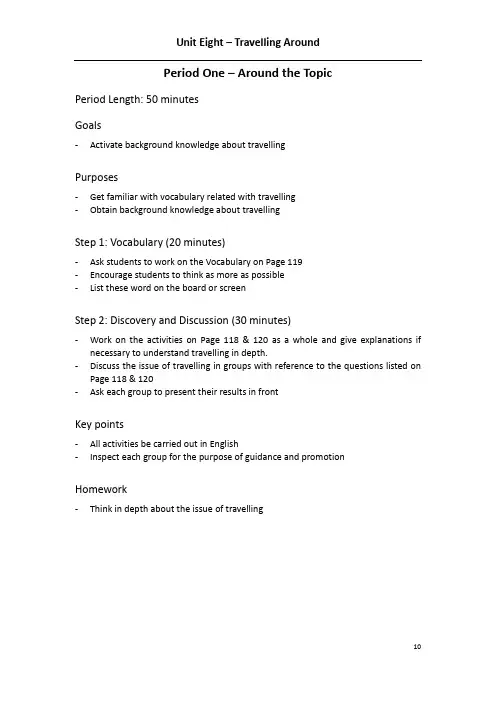
Period One – Around the TopicPeriod Length: 50 minutesGoals-Activate background knowledge about travellingPurposes-Get familiar with vocabulary related with travelling-Obtain background knowledge about travellingStep 1: Vocabulary (20 minutes)-Ask students to work on the Vocabulary on Page 119-Encourage students to think as more as possible-List these word on the board or screenStep 2: Discovery and Discussion (30 minutes)-Work on the activities on Page 118 & 120 as a whole and give explanations if necessary to understand travelling in depth.-Discuss the issue of travelling in groups with reference to the questions listed on Page 118 & 120-Ask each group to present their results in frontKey points-All activities be carried out in English-Inspect each group for the purpose of guidance and promotionHomework-Think in depth about the issue of travellingPeriod Length: 50 minutesGoals-Vocabulary and grammar-Discourse knowledgePurposes-Learn new words and expressions-Understand key grammar points-Understand related discourse knowledgeStep 1: Pre-reading Tasks (15 minutes)-Discuss briefly the questions on Page 121 in groups-Check briefly the preview results from studentsStep 2: Reading activity (Part One: 25 minutes)-Listen to the reading-Ask students to present new words and sentences in groups-Ask students to give feedbacks for the information presented-Give more explanations to the new words and sentences-Provide extra knowledge about new words-Guide more on sentences and grammarStep 3: Summarization (10 minutes)-Summarize the words and sentences-Summarize the text learntKey points-Instructions and tasks carried in English, Chinese is used only when necessaryHomework-Review the learnt sections-Preview the following parts and exercisesPeriod Length: 50 minutesGoals-Vocabulary and grammar-Discourse knowledgePurposes-Learn new words and expressions-Understand key grammar points-Understand related discourse knowledgeStep 1: Pre-reading Tasks (15 minutes)-Discuss briefly the previously learnt part for understanding-Check briefly the preview results from studentsStep 2: Reading activity (Part Two: 25 minutes)-Listen to the reading-Ask students to present new words and sentences in groups-Ask students to give feedbacks for the information presented-Give more explanations to the new words and sentences-Provide extra knowledge about new words-Guide more on sentences and grammar-Check the comprehension questions on Page 123Step 3: Summarization (10 minutes)-Summarize the words and sentences-Summarize the text learntKey points-Instructions and tasks carried in English, Chinese is used only when necessaryHomework-Review the learnt sections-Preview the following parts and exercisesPeriod Length: 50 minutesGoals-Enhance the vocabulary abilityPurposes-Learn detailed usage of certain words-Learn detailed usage of certain language structuresStep 1: Exercise A (15 minutes)-Work Vocabulary and Structure exercise A on Page 124 in groups -Check and compare answers in groups and negotiate them-Ask students to present their answers-Provide feedbacks for answersStep 2: Exercise B (15 minutes)-Work exercise B on Page 124 in groups-Check and compare answers in groups and negotiate them-Ask students to present their answers-Provide feedbacks for answersStep 3: Exercise C (20 minutes)-Work exercise C on Page 125 in groups-Check and compare answers in groups and negotiate them-Ask students to present their answers-Provide feedbacks for answersKey points-Instructions and activities be carried in EnglishHomework-Finish Writing Task on Page 125 and turn them in due next period -Prepare for the grammar and vocabulary exercisesPeriod Five – Language in UsePeriod Length: 50 minutesGoals-Grammar knowledge and vocabulary buildingPurposes-Passive Voice-Names of European countriesStep 1: Passive Voice (30 minutes)-Test grammar knowledge on Page 126 for checking grammar abilities-Work on exercises A, B & C on Pages 126 & 127 in groups-Ask students to present their answers and provide necessary explanations -Give supplementary information on those structures if necessaryStep 2: Names of European countries (20 minutes)-Work on exercise on Pages 127 in groups-Ask students to present their answers and explain-Give supplementary information on European countries if necessaryKey points-Give instructions in English-Explain grammar knowledge in ChineseHomeworkPeriod Six – Extension: Kenya SafariPeriod Length: 50 minutesGoals-Extend reading abilitiesPurposes-Apply previously learnt vocabulary and cultural knowledge in reading-Develop reading abilities-Improve abilities on negotiation and discussionStep 1: Reading (20 minutes)-Ask students to read Kenya Safari on Page 129 in groups-Understand new words and sentences within the group by negotiating in EnglishStep 2: Discussion (30 minutes)-Discuss questions listed on Page 129-Ask each group to present their opinions for the questions in front-Give feedbacks and remarks for presentationsKey points-Inspect group discussions and give guidance to promote discussionsHomework-Review previously learnt materials-Prepare for the ProjectPeriod Length: 50 minutesGoals-Teamwork abilitiesPurposes-Apply previously learnt words and cultural knowledge into actual use-Develop teamwork abilitiesStep 1: Brainstorming (25 minutes)-Brainstorm the ideas about travelling in Europe-Share your ideas with your partner about some famous tourist places you would like to visit and make a listStep 2: Planning (25 minutes)-Ask students to work in pairs or groups to work on your plan to European countries-Map out your itinerary on a map according to your preferences.Key points-All preparations and negotiations be carried in English-Give guidance while students prepare the projectHomeworkPeriod Length: 50 minutesGoals-See abovePurposes-See aboveStep 1: Presentation (25 minutes)-Present your plan and map in front. Use you imagination and try to make your trip sound interesting. Or you can organize a tour group and introduce the journey as if you were a tour guide.Step 2: Evaluation (25 minutes)-Give remarks to the presentations-Vote for the best presentations-Based on the results of presentation, discuss the questions: how to describe a place? How to make your travel plan clearly understood?Key points-Give instructions for discussion and evaluationHomework-Revise writings according to the feedbacks and remarks received-Turn the revised copies before next periodPeriod Nine – Culture Tips: Hotel, Hostel, B&B and Motel Period Length: 50 minutesGoals-Understand part of western culture from another perspectivePurposes-Help students to understand western culture-Help students to learn more cultural expressionsStep 1: Warm-up (15 minutes)-Read materials on Hotel, Hostel, B&B’s and Motel on Page 131-Help on any new words if necessaryStep 2: Open Discussion (35 minutes)-Ask students to offer more discussions about different types of hotels-Encourage students to pay more attention to the travelling activity in western cultureKey points-All activities be carried in EnglishHomeworkPeriod Ten – Learning to Learn Period Length: 50 minutesGoalsPurposesStep 1Step 2Key pointsHomework。
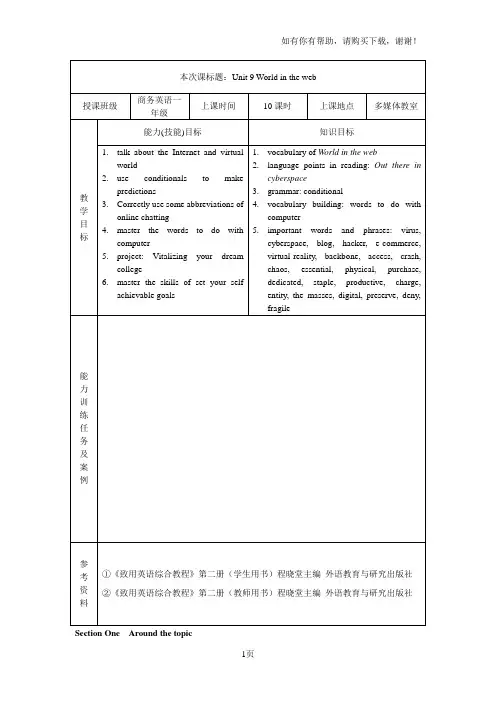
Section One Around the topicStep 1 Topic introduction:The topic of this unit is about cyberspace. This unit provides some information about the history of the internet and discusses some uses of the internet that have grown dramatically in recent years. The main reading text enables students to access and reflect on the future of cyberspace. In the Extension part, students will read about the benefits of a digital library.Step 2 watch the video1.Watch the video “April Fool’s Day in the Internet Age”. What tricks did the websites play?How are they different from the past?2.How has internet changed your life? Discuss in groups.Play the video twice and try to have students think about the questions in the PPT and then ask some volunteers to express their viewpoints.Step 3 Your ideasA.Which of the following famous IT faces do you recognize? Do you know what they arefamous for?Start the unit by encouraging students to think of IT entrepreneurs and their IT business success. The aim here is to get students talking about the benefits they enjoy in the electronic era. Ask students to identify the three IT entrepreneurs and match them to their companies.Conduct a class feedback and familiarize students with the benefits of high-tech products. If there is enough time, the teacher can add some questions such as how do they like the products of the above three companies, etc.B.How often do you use products made by these international IT giants? Has your life becomemore convenient since you started to use them? Share your ideas in pairs.Encourage student to discuss the effects of information technology on our daily life. You may elicit topics and write them on the board to start students thinking, e.g. travel, education, communication, food, interpersonal relationships, work, hobbies, sports, money, health, family, agriculture.C.How often do you do the following things?●check e-mail●chat on the net●buy things through internet●listen to music on the net●learn English on the net●play games●search information●read e-books●read news reports●watch movies onlineInvite some students to talk about their own internet experiences.Step 4 vocabularyA.Many web-related words are newly created or are common words assigned with newmeanings. Match the following words with their definitions.Ask students to do this exercise in pairs. Check answers by asking students to read out the definition of each word.Answers:1.BBS2.browser3.virus4.e-mail5.hacker6.cyberspace7.e-commerce8.blogB.Do you know any other new words in the computer world? Describe and explain them inpairs.Encourage students to brainstorm more words related to the cyberspace or the computer world.Step 5 Listening and speakingThe aim of this section is to help students learn about the drawbacks of searching information on the internet. Ask students to think of their own experiences of using the internet as a tool when doing homework. Is it time-consuming or is it worth the while to do so?Are you easily distracted by looking at other things? Play the recording and ask students to tell whether the statements are true or false.A.Listen to a man and a woman talking about surfing the internet. Decide whetherthe following statements are true (T) or false (F).Play the recording once or twice if necessary. Ask students to take notes while listening to the recording, and tell them the importance of taking note in the listening practice.And then ask for the feedback from several volunteers and check the answer together asa class.B.Listen again and answer the following questions.1.What has the man been doing for the last few hours?2.What information did the man want to find?3.Why does the woman say surfing the internet can be distracting?4.What is the thing the man really doesn’t like about the internet?Play the recording again and encourage students to improve their notes and find answers from the notes. Then check the answer as a class.C.Work in groups and discuss the following questions.1.How convenient is it for you to use the internet on campus?2.Do you regularly chat in a certain online group? What’s it about?3.What topics do you usually talk about when you chat online?Divide students into groups and have them discuss on the above questions and exchange ideas, then ask several representatives from each group to express their ideas.Section two ReadingStep 1 introductionThe topic of this unit is about cyberspace. This unit provides some information about the history of the internet and discusses some uses of the internet that have grown dramatically in recent years. The main reading text enables students to access and reflect on the future of cyberspace.This is an argumentative article, aiming at discussing the future of the internet. In the firsttwo paragraphs, the writer presents the definition of cyberspace and the influence of the internet---the soaring use of the internet leads to the heated discussion of the net future. In the following paragraphs, the writer views the net future from two opposite opinions. Some are pessimistic, particularly because of the threat of cybercrimes. Others are optimistic, because life has been made easier and more convenient. This article ends with uncovering the nature of the internet---a non-existing entity.Step 2 pre-reading questionsDiscuss the following questions in groups:1.In what way has the Internet made our life easier or less convenient?Read the question as a class. Divide students into groups and assign a group leader to take notes on the advantages and disadvantages of using the net.1.Imagine life in the next 20 years. How do you think the Internet will further change our lives? Ask students to discuss he question in pairs or groups. Students may have interesting and creative ideas. Let their imagination go!Step 2 Text illumination1)Ask several students to read the whole text in order to check whether they preview thetext and get a general understanding bout it or not beforehand.2)Ask students to summarize the text3)The teacher can put the comprehension check either before or after illuminating the textaccording to the needs of class and the students’ comprehension ability.4)Illuminate the text, during the process of which the teacher can encourage students tohighlight or underline the important parts when they read the text in detail. Try to explain that it can help students to grasp the important details and review important points Language points:1. backbone n. the most important part of an organization or group of people 骨干,中坚e.g. Such people are the backbone of the country.2. case n. actual state of affairs; situation 实情,情况e.g. If that’s the case, you’ll have to work harder.3. access n. opportunity or right to use sth. 使用某物的机会或权利e.g. Students must have access to a good library.4. cyberfraudster n. a person who deceives people on the Internet in order to gain money, power, etc. 网络骗子e.g. The Internet has given birth to the cyberfraudster5. chaos n. a state of complete disorder and confusion 混乱;无秩序状态e.g. The wintry weather has caused chaos on the roads.6. crash v. to (cause to) have a sudden, violent, and noisy accident(使)猛撞,(使)撞毁e.g. The plane crashed into the sea.7. essential adj. extremely important and necessary 必要的,不可缺少的,最重要的8. simulated adj. not real, but made to look, sound, or feel real 伪装的,模仿的e.g. The movie’s simulated tropical storm used up huge quantities of water.9. undoubtedly adv. used for saying that sth. is certainly true or is accepted by everyone 无疑地,肯定地e.g. The painting is undoubtedly genuine.10. assimilation n. the process of becoming an accepted part of a country or group 融合,同化assimilate v.e.g. The USA has assimilated people from many different countries.11. physical adj. relating to real objects that you can touch, see, or feel 物质的e.g. the physical world around us the physical environment12. purchase v. to buy sth. 购买e.g. They purchased a large house.13. the masses all the ordinary people in society who do not have power or influence 劳动者阶层e.g. Leaders should trust and rely on the masses.14. dedicated adj.made for or used for only one particular purpose 专用的e.g. a dedicated word processor15. staple n. the main product that is produced in a country 主要产品e.g. Cotton is one of Egypt’s staples.16. productive adj. causing or resulting in sth. 造成某种结果的;产生某种事物的e.g. The changes were not productive of better labor relations.17. charge v. to ask someone to pay for sth. you are selling 收费e.g. I’m not going there again—they charged me £1 for a cup of coffee!18. entity n. things with distinct and real existence 实体e.g. The mind and the body are seen as separate entities.Step 3 Post-reading exercises1.The following sentences are taken form the text. Put them back in the correct place.1)We will work in virtual offices, shop in virtual supermarkets, and we will even study invirtual schools.2)In the 1980s, there were only hundreds of users3)Secondly, it is a sort of modern library where anything imaginable can be researched.4)The internet is now also seen as a new form of expression---freedom.5)Information can be easily downloaded using a searching engine.Have students scan the text. Set a gist question, such as “what are the changes brought by the wide use of the internet” to test students’ overall understanding of the text. Then ask students to complete the text with the missing sentences. Let students check their answers in pairs before checking with the whole class.2.Why do experts worry about the future of cyberspace? Why do people feel optimistic aboutthe internet future? Find reasons in the text.Ask students to do this task in pairs. Tell them to look at the two opposite viewpoints and skim through the text to find supporting evidence for each viewpoints. Remind them to underline or note down the evidence and discuss with their partners. When you give feedback, elicit evidence from different pairs and discuss why student s’ views differ.Answers:Reasons to be optimisticWorking lives and leisure time are being changed. The internet has become an essential part of life at our universities, offices, schools and homes.●It has given people a new way to communicate, through e-mail and webcams. Messagesare being sent to people all over the planet form other people who have access to the internet.●With the development of multimedia software, people can click their mouse on a page,view a film clip and listen to music at the same time.●The way we do business and shop are being changed by electronic commerce. Reasons to be pessimisticOne worry is the activity of cyber crime●Young hackers can get into the computer systems of banks and governments.●Cyber fraudsters may deceive people in order to gain money and power.●Cyber terrorists may use the internet to damage computers to cause chaos, and makeplanes and trains crash.3.Vocabulary and structureA.Read the text again. Match the words with their definitionsAsk students to find and underline the words in the corresponding sentences in the text. Tell them to work out the meaning of words from the context. Go around the class to monitor their work and offer any necessary help. Check their answers when they finish.Answers:1.case: an example of a particular situation or of something happening2.cyberfraudster: someone who cheats people on the internet3.chaos: a confused and disordered situation4.staple: the main product that is produced in a country5.entity: something that exists as a single and complete unit6.deceive: to trick someone7.charge: to ask someone to pay8.physical: relating to real objects that you can touch, see or feelB.Read the following sentences taken from the text. Underline the verbs referring to the futureand decide:a.which talks about a future event we can predict from present situation.b.which expresses our views and intentions in the near future.The aim here is to practice using “will”and “be going to do”to talk and write about the future. Ask students to work in pairs, find the sentences in the text and discuss the uses of the two future forms.C.Study the meaning of conjunction “as” in the following sentences. Then explain the meaningof “as” n sentences 1-4Have students read the sample sentences. Clarify and summarize the function of “as” in each sample sentence. Ask students to explain the meaning of “as” in the following sentences.Answers:1.at the same time2.because3.what Napoleon has said before4.although4. WritingSome people are optimistic about the future of cyberspace, but some are pessimistic about the changes brought by the use of the internet, write a paragraph about the predictions you make about the life by the year 2050. you may start by listing the possible changes or problems of the internet.Elicit both optimistic and pessimistic predictions. Help students state and list their views onthe board, for example, “I think there will be no newspapers”, “I think all newspapers will be in color.” Ask students to discuss the future of cyberspace in small groups. The groups report to the class and see if their views are shared by the rest of the class. Remind students of the correct use of future forms and computer vocabulary in their writing. This task can be either left as homework for students or done on class if time is enough.Section 3 Language in use: type 1 conditional and type 2 conditionalStep 1 test your grammarStudents may have already learned the different uses of the modal verb “would”. However, they may find themselves not so sure about the correct answer to these questions. This grammar exercise aims to further enhance students’ understanding of “would”.Read the examples sentences as a class. Ask students to explain the use of “would” in each sentence.The word “would”has several different uses. Look at these examples and decide which sentence expresses the future in the past, which expresses a situation which is contrary to reality and which expresses a habitual behavior in the past.a.When I was a kid, I would get up at 7:00 and take the dog for a walk.b.If I were taller, I would join the police force.c.In Paris Hans met Christina, whom he would marry three years later.Step 2 illumination and developmentBriefly explain the grammatical knowledge of the uses of “type 1 conditional and type 2 conditional”. Then ask students to finish these exercises. Check their work when they finish. Type 1 conditionalType 1 conditional is used to discuss things that will probably happen in the future as the result of something else that happens in the present.The first conditional consists of two clauses, one with If + simple present verb and the second with simple future verb, as in, "If you do something bad, something bad will happen to you."We can also use the first conditional to make predictions about the future. For example, we can predict that "If my brother crashes the car tonight, my mother will be furi ous.” Type 2 conditionalType 2 conditional refers to present and future situations. It is used to talk about unreal—impossible, improbable or imaginary—situations. It refers to an unlikely or hypothetical condition and its probable result.Type 2 conditional consists of two clauses, one with if + subject + simple past verb and the second with subject + would + verb, as in, “I would buy a big house if I had a million dollars.”Step 3 Doing exercisesThen ask students to finish these exercises. Check their work when they finish. Try to encourage students to explain the answers by themselves. The teacher is supposed to offer some explanations where necessary.plete the sentences with the correct form of the verbs in the brackets.Ask students to fill the gaps with the correct form of verbs according to Type 1 conditional. Ask for class feedback when they finish.B.Who would say these things, A or B?Remind students that these statements are not based on facts.e the cues below to write Type 2 conditional. The first one has been done as an example. Ask students to think of the Type 2 situations in which the statements would be appropriate.Step 4 Vocabulary building: words to do with computerThis section aims to expand students’computer-related vocabulary by forming compounds and collocations.With the development of computer technology, many new words related to computer are created by way of combination, which has greatly enlarged the English vocabulary.1、词义转移、引申许多计算机英语词汇从普通英语中转移过来,词义转移或引申是构建计算机英语词汇的一种常见的方法。
Section One Around the topicStep 1 Topic introduction:The topic of this unit is about time management. Students often feel anxious because they have a lot of things to do and there’s never enough time. One big problem is that they don’t know how to manage their time. Time is fair to every one. We should learn to do things efficiently. Step 2 Your ideasBelow are some sayings about time. What do they mean? Do you agree with them? Work in groups and discuss your understanding of each saying.Time flies 时光飞逝。
Time is money 时间就是金钱。
Time and tide wait for no man. 岁月不等人。
Time stays long enough for anyone who will use it.对于善于使用的人来说,时间总是足够长。
Time you enjoyed wasting is not wasted time.你高高兴兴“浪费”掉的时间不算浪费时间。
To think too long about doing a thing often becomes its undoing.做事时考虑的太多反而做不成事。
There is never enough time to do everything, but there is always enough time to do the most important things.永远没有做够的实践来做所有的事,但永远有足够的时间来做最重要的事儿。
Period One – Around the TopicPeriod Length: 50 minutesGoalsPeriod Length: 50 minutesGoals-Activate background knowledge about workPurposes-Get familiar with vocabulary related with work-Obtain background knowledge about curiosity and being inquisitiveStep 1: Vocabulary (20 minutes)-Ask students to work on the Vocabulary on Page 150-Encourage students to think as more as possible-List these word on the board or screenStep 2: Discovery and Discussion (30 minutes)-Work on the activity on Pages 150 & 151 as a whole and give explanations if necessary to understand the necessity of work-Discuss the issue of work with reference to the questions listed on Pages 150 & 151-Ask each group to present their results in frontKey points-All activities be carried out in English-Inspect each group for the purpose of guidance and promotionHomework-Think in depth the advantages and disadvantages of being curiousPeriod Length: 50 minutesGoals-Vocabulary and grammar-Discourse knowledgePurposes-Learn new words and expressions-Understand key grammar points-Understand related discourse knowledgeStep 1: Pre-reading Tasks (15 minutes)-Discuss briefly the short passage on Page 152 in groups-Check briefly the preview results from studentsStep 2: Reading activity (Part One: 25 minutes)-Listen to the reading-Ask students to present new words and sentences in groups-Ask students to give feedbacks for the information presented-Give more explanations to the new words and sentences-Provide extra knowledge about new words-Guide more on sentences and grammarStep 3: Summarization (10 minutes)-Summarize the words and sentences-Summarize the text learntKey points-Instructions and tasks carried in English, Chinese is used only when necessaryHomework-Review the learnt sections-Preview the following parts and exercisesPeriod Length: 50 minutesGoals-Vocabulary and grammar-Discourse knowledgePurposes-Learn new words and expressions-Understand key grammar points-Understand related discourse knowledgeStep 1: Pre-reading Tasks (15 minutes)-Discuss briefly the previously learnt part for understanding-Check briefly the preview results from studentsStep 2: Reading activity (Part Two: 25 minutes)-Listen to the reading-Ask students to present new words and sentences in groups-Ask students to give feedbacks for the information presented-Give more explanations to the new words and sentences-Provide extra knowledge about new words-Guide more on sentences and grammar-Check the comprehension questions on Page 154Step 3: Summarization (10 minutes)-Summarize the words and sentences-Summarize the text learntKey points-Instructions and tasks carried in English, Chinese is used only when necessaryHomework-Review the learnt sections-Preview the following parts and exercisesPeriod Length: 50 minutesGoals-Enhance the vocabulary abilityPurposes-Learn detailed usage of certain words-Learn detailed usage of certain language structuresStep 1: Exercise A (15 minutes)-Work Vocabulary and Structure exercise A on Page 155 in groups -Check and compare answers in groups and negotiate them-Ask students to present their answers-Provide feedbacks for answersStep 2: Exercise B (15 minutes)-Work exercise B on Page 155 in groups-Check and compare answers in groups and negotiate them-Ask students to present their answers-Provide feedbacks for answersKey points-Instructions and activities be carried in EnglishHomework-Finish Writing Task on Page 156 and turn them in due next period -Prepare for the grammar and vocabulary exercisesPeriod Five – Language in UsePeriod Length: 50 minutesGoals-Grammar knowledge and vocabulary buildingPurposes-Present Simple and Present Continuous-Phrasal VerbsStep 1: Present Simple and Present Continuous (30 minutes)-Test grammar knowledge on Page 157 for checking grammar abilities-Work on exercises A, B & C on Pages 157 & 158 in groups-Ask students to present their answers and provide necessary explanations -Give supplementary information on those structures if necessaryStep 2: Phrasal Verbs: Liberal or Idiomatic? (20 minutes)-Work on exercises A & B on Pages 159 in groups-Ask students to present their answers and explain phrasal verbs-Give supplementary information on phrasal verbs if necessaryKey points-Give instructions in English-Explain grammar knowledge in ChineseHomeworkPeriod Six – Extension: Do jobs change people? Period Length: 50 minutesGoals-Extend reading abilitiesPurposes-Apply previously learnt vocabulary and cultural knowledge in reading-Develop reading abilities-Improve abilities on negotiation and discussionStep 1: Reading (20 minutes)-Ask students to read Do Jobs Change People? on Page 162 in groups-Understand new words and sentences within the group by negotiating in English -Finish Vocabulary Check on Page 163Step 2: Discussion (30 minutes)-Discuss the job related topics in class-Ask each group to present their opinions for the questions in front-Give feedbacks and remarks for presentationsKey points-Inspect group discussions and give guidance to promote discussionsHomework-Review previously learnt materials-Prepare for the ProjectPeriod Length: 50 minutesGoals-Teamwork abilitiesPurposes-Apply previously learnt words and cultural knowledge into actual use-Develop teamwork abilitiesStep 1: Search for a Job Vacancy (25 minutes)-Work in groups and decide which role you would like: a job hunter or an interviewer? With reference to Page 160.-Read the above help-wanted ad. What qualities are needed for a good manager?Step 2: Vocabulary (25 minutes)-Ask students to work in pairs or groups to work on the vocabulary about jobs-Write down the questions you should ask the job hunter or interviewer.Key points-All preparations and negotiations be carried in English-Give guidance while students prepare the projectHomeworkPeriod Length: 50 minutesGoals-See abovePurposes-See aboveStep 1: Act out a job Interview (25 minutes)-Find a partner, either a job applicant or an interviewer and act out an interview.Be polite and friendly. You should at least interview or being interviewed once. .Step 2: The Best Person for the Job (25 minutes)-Students who have conducted interviews report to the class. First tell the class which questions you asked and then state clearly the reasons why you think you have chosen the right applicant.-Give remarks to the presentations-Group members should also talk about what they have learnt from this project.Key points-Give instructions for discussion and presentationHomework-Revise writings according to the feedbacks and remarks received-Turn the revised copies before next periodPeriod Nine – Culture Tips: What Drives US EmployeeSatisfactionPeriod Length: 50 minutesGoals-Understand part of western culture from another perspectivePurposes-Help students to understand western culture-Help students to learn more cultural expressionsStep 1: Warm-up (15 minutes)-Read materials on What Drives US Employee Satisfaction on Page 164-Help on any new words if necessaryStep 2: Open Discussion (35 minutes)-Ask students to offer more stories related to the topic-Encourage students to pay more attention to the situations that may occur in the job situations in the future.Key points-All activities be carried in EnglishHomeworkPeriod Ten – Learning to Learn Period Length: 50 minutesGoalsPurposesStep 1Step 2Key pointsHomework。
教学内容教学方法Unit 1 EducationText B/Practical WritingObjectives:In this class, students willbuild up vocabulary relating to campus life;learn something from an ancient Greek educator;write an introduction of himself/herself、Oral PresentationWhat does college life mean to you? What does it offer you besides courses and exams? Text B: SocratesReading & Understanding* Finish the prehension exercises A & B onpage 12 after reading the text、* Check the answers with the students、Word Explanation:1、eager adj、热切得,渴望得e、g、(1) The boy was eager for success、(2) The girl was eager to see the gift her parents bought her、eagerness n、2、wisdom n、智慧,学识e、g、 a man of wisdom 有智慧得人wise adj、智慧得, 明智得e、g、 a wise decision 英明得决定a wise man 睿智得人首先让学生明确本次课得学习目标。
承接上一次课内容,训练学生得口语表达能力。
选择2-3个学生进行呈述。
Text B1、要求学生快速阅读一遍课文2、在学生读完后,让各小组讨论如何回答这些问题。
备注:
1.页面大小可自行添减,每上一次课写一份上述格式教案,一次课一般2个学时。
2.近三年参加工作的青年教师必须写详案。
3.手写教案格式参照表格内容。
备注:
1.页面大小可自行添减,每上一次课写一份上述格式教案,一次课一般2个学时。
2.近三年参加工作的青年教师必须写详案。
3.手写教案格式参照表格内容。
1.页面大小可自行添减,每上一次课写一份上述格式教案,一次课一般2个学时。
2.近三年参加工作的青年教师必须写详案。
3.手写教案格式参照表格内容。
备注:
1.页面大小可自行添减,每上一次课写一份上述格式教案,一次课一般2个学时。
2.近三年参加工作的青年教师必须写详案。
3.手写教案格式参照表格内容。
备注:
1.页面大小可自行添减,每上一次课写一份上述格式教案,一次课一般2个学时。
2.近三年参加工作的青年教师必须写详案。
3.手写教案格式参照表格内容。
职业技术学院教案
备注:
1.页面大小可自行添减,每上一次课写一份上述格式教案,一次课一般2个学时。
2.近三年参加工作的青年教师必须写详案。
3.手写教案格式参照表格内容。
职业技术学院教案
备注:
1.页面大小可自行添减,每上一次课写一份上述格式教案,一次课一般2个学时。
2.近三年参加工作的青年教师必须写详案。
3.手写教案格式参照表格内容。
职业技术学院教案
备注:
1.页面大小可自行添减,每上一次课写一份上述格式教案,一次课一般2个学时。
2.近三年参加工作的青年教师必须写详案。
3.手写教案格式参照表格内容。
职业技术学院教案
备注:
1.页面大小可自行添减,每上一次课写一份上述格式教案,一次课一般2个学时。
2.近三年参加工作的青年教师必须写详案。
3.手写教案格式参照表格内容。
职业技术学院教案
备注:
1.页面大小可自行添减,每上一次课写一份上述格式教案,一次课一般2个学时。
2.近三年参加工作的青年教师必须写详案。
3.手写教案格式参照表格内容。